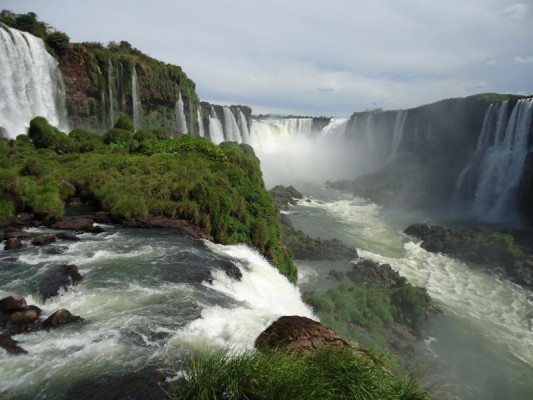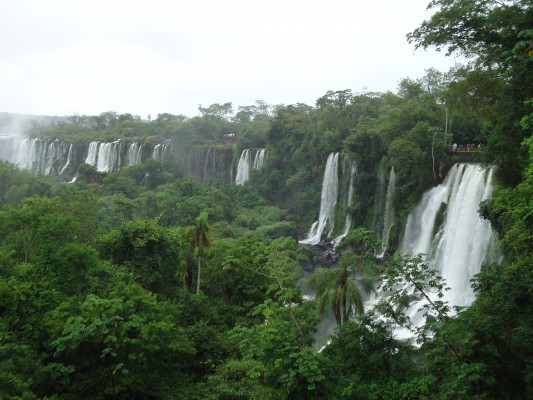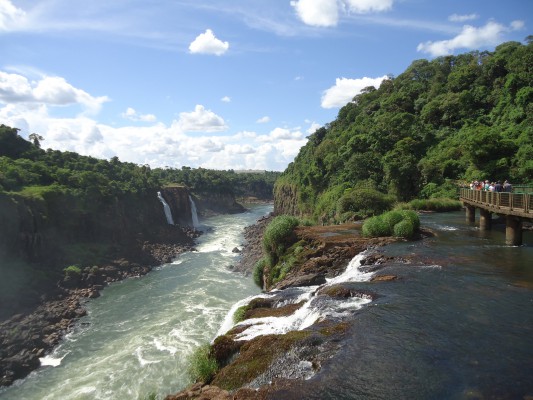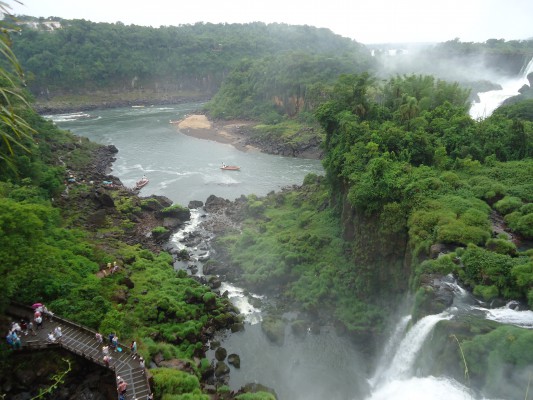One of the highlights of my trips to South America was visiting Iguazu Falls (or Iguaçu in Portuguese). Although I don’t pay a lot of attention to the various “Wonders of the World” lists, simply because there are too many to remember, it’s not hard to see why Iguazu made it on to one of them. The long stretch of falls set in lush green forest makes for a picturesque location, while its overwhelming power has to be seen to be believed. Situated on the border of Argentina, Brazil and Paraguay, Iguazu Falls is a considerable distance from most major cities. Getting there takes some time, but it is absolutely worth the effort.
Iguazu Falls: Brazillian Side
Figuring out the best way to explore this mammoth icon might seem a bit daunting; which country is best to view the falls from, which is the better experience, should you just go to both? With so many variables, the option of booking a tour might seem appealing. But there a few simple tips that make doing it yourself fun and easy, and guarantee a memorable experience.
The first thing to determine is where you are approaching the falls from. For most travellers, this will be somewhere in Brazil or Argentina. If you are in Brazil, you will be heading to Foz do Iguacu. If you are arriving from Argentina, your destination will be Puerto Iguazu. Both are located very close to the border and the falls in their respective country, and are easy to travel between.
Iguazu Falls: Argentinian Side
If you book early enough, internal flights within Brazil to Foz do Iguacu may be similar in price to bus fares. For those that are planning as they go, a night bus is your best option. I arrived in Foz on an overnight bus from Bonito, and left on an overnight bus to Sao Paulo. Each bus took about 16 hours, highlighting the remote location of the falls. On the other side of the border, the fastest, and most expensive, way to get to Puerto Iguazu is to fly. I’ve never done an overnight bus journey in Argentina, but I’ve been told that their buses are the best in South America; with seats that recline so far they are practically beds, decent food and even local wine. I was impressed with the long distance buses I took in Peru, so I’m imagining the Argentine ones to be something like business class. Make sure you take the first class bus (bus cama), as it is a long journey and it’s worth being comfortable. The trip by bus from Buenos Aires to Puerto Iguazu takes about 18 hours.
If you are taking a night bus anywhere in South America, I recommend having a small blanket with you. Some buses provide them, but it’s a necessity on the ones that don’t. I got a few funny looks from other travellers when they saw that I had squashed one into my backpack. It’s also worth remembering that bus travel in South America often takes an hour or two longer than the advertised time.
When you get to your destination, the question becomes whether you should see the falls in both Argentina and Brazil. The good news is that you don’t need to make a difficult choice between the two. Public buses travel across the border, making a day trip to the other side easy and ideal. After you cross the border, you will arrive at the terminal in the neighbouring town, where you change to a bus going to the falls. The trip shouldn’t take more than an hour in total (assuming there isn’t a long line at the border). Taxis will also be happy to drive you across, but you will pay a lot more for the convenience.
So is it worth visiting both sides? The answer is: absolutely! They are both completely different experiences.
The Brazilian side offers panoramic views of the falls, with an easy to follow trail running along the river. There are a series of spectacular viewpoints along the way, perfect for your landscape photos. It is not until you reach the end of the trail that you experience the full magnitude of Iguazu. A boardwalk leads you across the water to peer over the edge of a steep drop below. To your left, water is rapidly spilling over the pinnacle of the falls, Garganta del Diablo (the Devil’s Throat), plunging with massive force into the river that forms the border between the two countries. Looking downstream to your right, the water seems to flow calmly in comparison. A helicopter tour over the falls is also available on the Brazilian side; the cost is US$100 for a 10 minute flight. Bring your passport with you. This side of the falls can be explored in about half a day.
Iguazu Falls: Brazillian Side
Iguazu Falls: Brazillian Side
Entering the park on the Argentinian side felt like Disneyland for a moment, with its gift stores, food outlets, train and choice of activities. But the added tourist infrastructure doesn’t take away from the experience. This side takes you closer to the falls through a series of waterside trails. Winding through Iguazu’s jungle fringed surroundings, the trails allow you walk up next to, and sometimes even above, the thunderous white water flowing over lush green cliffs. On this side of Iguazu you can take a boat underneath the falls (US$60) and across to a small beach on the river. The free train that runs through the park will bring you to the main attraction, where you can feel the mist on your face as you look down into the Devil’s Throat – an experience not to be missed.
Iguazu Falls: Argentinian Side
Like most places in South America, rain is always a possibility. Even though you do get wet on the boat under the falls, you will find yourself pretty cold if you are stuck without a rain jacket if there is a downpour later in the day. If the activities available on the Argentine park are within your budget, it’s worth spending a full day on this side of the falls.
However you choose to get there, Iguazu Falls is a “must see” part of your South American journey, and worth every moment spent on the freezing night bus that gets you there.
Written by Bronwyn Hager www.whereisbron.com








